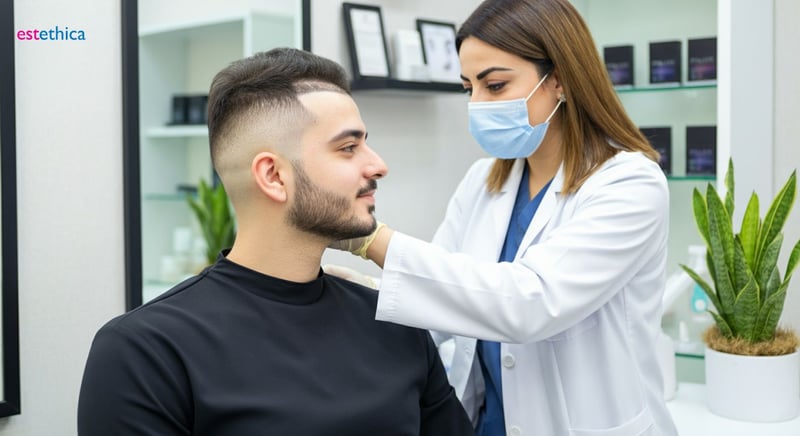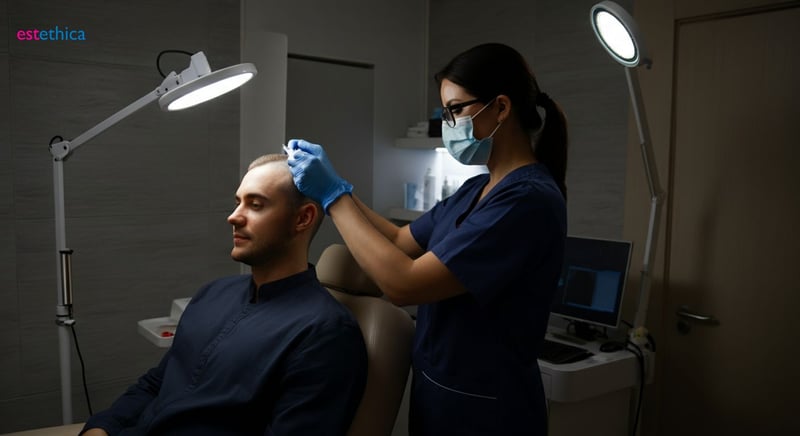Unlocking Hair Restoration: A Comprehensive Guide
Discover the journey to reclaiming your hair's vitality, with expert insights and innovative solutions at estethica.
Welcome to estethica, where patient safety and world-class hair restoration techniques converge. In this comprehensive guide, we delve into the science and solutions behind hair loss, exploring both surgical and non-surgical options available to individuals seeking to restore their hair. Whether you're considering a follicular unit extraction (FUE) or follicular unit transplantation (FUT), or looking into non-invasive solutions, our aim is to equip you with the knowledge needed to make informed decisions about your hair restoration journey.
Understanding Hair Loss: Identifying the Root Causes
Decoding Androgenetic Alopecia: The Hereditary Factor
Hair loss affects millions, with causes varying from genetics to environmental factors. Androgenetic alopecia, a common type, arises from hereditary factors, leading to gradual thinning. Those considering hair restoration should understand that genetics play a crucial role. Identifying this predisposition early can aid in tailored treatment plans from clinics like estethica Global, ensuring a proactive approach to managing hair thinning.
- Genetic Predisposition: Inherited traits impacting hair follicle sensitivity to androgens.
- Gradual Thinning: Progressive hair density reduction, varying across the scalp.
- Hormonal Influence: Androgens like DHT affecting susceptible hair follicles.
Understanding the influence of genetics highlights the importance of early consultation and tailored hair loss treatment. Recognizing hereditary patterns allows for better management and realistic expectations regarding potential interventions.
The Broader Spectrum: Identifying Non-Genetic Causes
Beyond genetics, various factors contribute to hair loss, including hormonal imbalances, stress, and nutritional deficiencies. Hormonal fluctuations can affect hair thickness, while chronic stress may disrupt the hair growth cycle. Nutritional gaps, especially in iron and vitamins, can weaken hair strands, so it is important to know how to treat hairloss. Addressing these non-genetic causes is pivotal in a comprehensive approach to hair loss treatment.
- Hormonal Evaluation: Checking thyroid levels and sex hormones for imbalances.
- Stress Management: Implementing methods to reduce chronic stress levels.
- Nutritional Assessment: Identifying and correcting nutrient deficiencies, like vitamins.
Proper diagnosis and personalized care are essential in addressing these multifaceted factors, ensuring effective strategies for hair restoration and maintaining scalp health. Recognizing these diverse influences underscores the necessity of consulting with specialists for tailored interventions.

Hair Transplant Techniques: FUE vs. FUT – Which is Right for You?
Comparing FUE and FUT: Minimally Invasive vs. Maximum Grafting
Deciding between FUE and FUT can be challenging, yet both techniques offer unique benefits. FUE has gained popularity due to its minimally invasive nature, utilizing tiny punches to extract each hair follicle, which minimizes scarring. Advances in FUE technology, such as the use of sapphire instruments, further enhance the precision of hair placement. Conversely, FUT involves removing a strip of scalp tissue, which can result in a linear scar but allows the transplantation of a larger number of grafts in a single session. At estethica, the choice between FUE and FUT depends on the patient's scalp condition, desired outcomes, and recovery considerations. estethica Global approaches each case individually, ensuring personalized solutions that align with patient needs. Hair restoration options are widely available. Follicular unit extraction is frequently preferred, however, sometimes follicular unit transplantation is the best option for certain patients.
- Scarring Differences: FUE minimizes visible scarring compared to the FUT's linear scar.
- Graft Quantity: FUT can provide a higher quantity of grafts in a single procedure.
- Recovery: FUE generally offers a quicker recovery due to its less invasive nature.
The selection of either FUE or FUT should be based on a detailed evaluation, including hair density, hair loss pattern, and individual preferences. This ensures the chosen method aligns with the patient’s specific goals for hair restoration. At estethica, they provide advanced hair grafting techniques.
Determining the Best Option: Factors Influencing the Choice
The suitability of FUE versus FUT largely depends on several factors, including the extent of hair loss, scalp elasticity, and the patient's lifestyle. Individuals needing extensive coverage might benefit from FUT, while those favoring minimal downtime may lean towards FUE. During consultations at estethica, surgeons assess these aspects to recommend the best approach for patients seeking hair transplant. Considering long-term lifestyle and aesthetic goals ensures satisfaction with the chosen technique. Sapphire instruments enhance the precision of hair transplant, offering better aesthetic results.
- Scalp Elasticity: Assesses how well the scalp can accommodate FUT's strip excision.
- Extent of Loss: Determines the number of grafts needed for adequate coverage.
- Lifestyle Factors: Considers activities that may affect recovery and scarring.
Ultimately, the decision between FUE and FUT hinges on a comprehensive understanding of each patient's unique condition and expectations. This collaborative approach ensures that patients receive the most appropriate and effective hair loss treatment, tailored to their individual needs. The cost for fue hair transplant will depend on your individual plan. estethica's emphasis on personalized consultations helps patients make informed choices about their hair restoration journey.

Non-Surgical Hair Loss Solutions: Exploring Your Options
Understanding Scalp Micropigmentation (SMP)
Scalp micropigmentation (SMP) offers a cosmetic solution for those experiencing hair loss, particularly when surgery is not an option or desired. This technique involves the application of tiny pigment deposits to the scalp, mimicking the appearance of hair follicles. SMP is effective for creating the illusion of a fuller head of hair, covering bald spots, and reducing the contrast between the scalp and hair color. At estethica, SMP is performed by skilled technicians who customize the pigment shade to match the patient's natural hair color and skin tone. Using advanced techniques ensures a natural-looking result. Those who want a hair transplant may consider other options.
- Cosmetic Illusion: Creates the visual effect of a fuller head of hair.
- Customized Pigment: Tailored to match individual hair color and skin tone.
- Non-Invasive: No surgery required, making it a safe, non-surgical hair loss treatment.
SMP offers an immediate aesthetic improvement with minimal downtime. This hair loss treatment provides a practical solution for individuals seeking to enhance their appearance without undergoing surgical procedures. estethica focuses on delivering personalized SMP treatments that meet each client's specific aesthetic goals, improving confidence and satisfaction.
Exploring Topical Treatments and Medications
Topical treatments and medications like minoxidil and finasteride are popular non-surgical options for managing hair loss. Minoxidil stimulates hair follicles, promoting regrowth and slowing hair thinning. Finasteride, on the other hand, is an oral medication that prevents the conversion of testosterone to dihydrotestosterone (DHT), a hormone linked to hair loss. These treatments are often recommended to slow the progression of hair loss and, in some cases, restore some hair density. The cost for these options is minimal.
- Minoxidil: Applies topically to stimulate hair follicles.
- Finasteride: Taken orally to block DHT production.
- Combined Approach: Using both can enhance effectiveness of hair loss treatment.
Medical interventions should be overseen by a healthcare professional to monitor effectiveness and manage potential side effects. estethica provides thorough consultations to evaluate the suitability of these treatments, ensuring they align with individual health profiles and hair restoration goals. The approach combines medical expertise with personalized care to maximize the benefits of non-surgical interventions. It is possible to get a hair transplant later.

Is Hair Transplant Permanent? Managing Expectations and Long-Term Care
The Longevity of Hair Transplants: Understanding the Factors
While hair transplants offer a durable solution to hair loss, their permanence is influenced by several factors. Transplanted hair, typically extracted from DHT-resistant areas, exhibits greater resilience. However, native, non-transplanted hair can continue to thin over time, affecting overall density. Therefore, managing expectations and adopting a proactive approach are integral to maintaining a fuller head of hair. Regular consultations and personalized care play a major role in guaranteeing better long-term results. Hair restoration goes beyond the procedure, it includes aftercare for the patient.
- DHT Resistance: Transplanted follicles are less susceptible to DHT's shrinking effects.
- Ongoing Loss: Native hair may still be prone to thinning.
- Maintenance Impact: Consistent care affects the longevity of results.
Long-term success requires adapting to individual needs and implementing strategies that safeguard both transplanted and existing hair. estethica provides guidance and support to help patients navigate these considerations and optimize their hair restoration outcomes with a hair grafting option. This dedication guarantees continued satisfaction and lasting results.
Sustaining Your Investment: Long-Term Care and Maintenance
To ensure the longevity of a hair transplant, ongoing care is crucial. This includes lifestyle adjustments, adherence to prescribed treatments, and regular evaluations by specialists. Lifestyle factors, such as diet and stress management, impact hair health, while treatments like minoxidil and finasteride can help preserve non-transplanted hair. Consistent follow-ups at clinics like estethica enable timely adjustments to care plans. Hair loss treatment requires continued dedication and adaptation.
- Lifestyle Adjustments: Includes diet, stress management, and scalp care.
- Medical Treatments: Minoxidil and finasteride can protect existing hair.
- Regular Evaluations: Monitoring and adjusting treatment plans for optimal results.
Through diligent maintenance and expert guidance, individuals can maximize the benefits of their hair transplant procedure, ensuring a fuller, healthier head of hair for years to come. estethica emphasizes the importance of combining advanced techniques, such as fue hair transplant, with comprehensive aftercare to achieve enduring satisfaction. These hair implants can last a lifetime.
Advanced FUE and FUT Techniques for Personalized Hair Restoration
Comprehensive Hair Restoration Processes for Optimal, Lasting Results
Frequently Asked Questions
What are the primary causes of hair loss?
What are the key differences between FUE and FUT hair transplant techniques?
What non-surgical options are available for hair loss treatment?
Is a hair transplant permanent, and what factors influence its longevity?
How can I ensure the best long-term results after a hair transplant?
Achieve your aesthetic goals with estethica; call today for expert guidance and personalized solutions!
📞 Book Your Free Consultation!